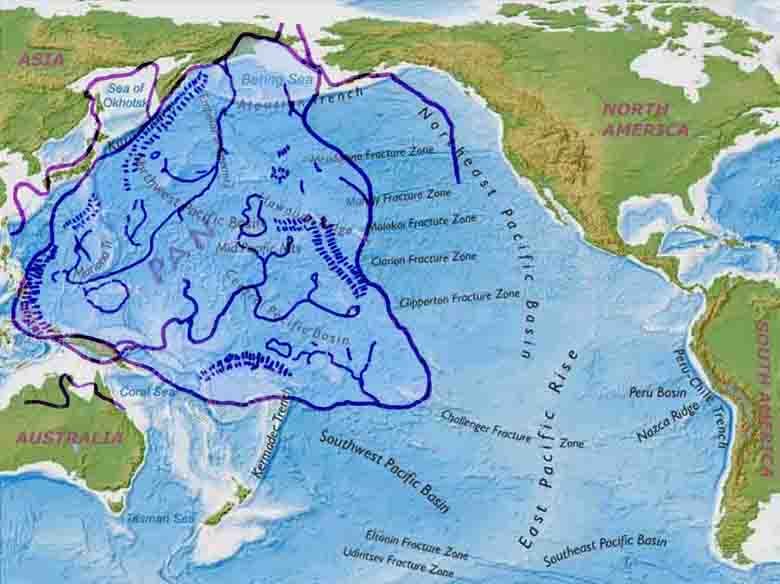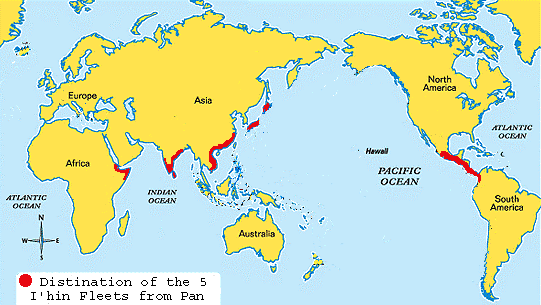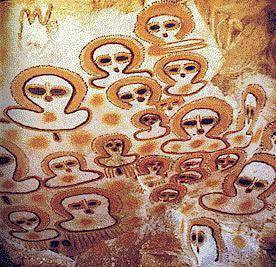Oahspe Study
Stories of the Flood (the Deluge) Part 3 |
|
|
||||||||
|
Flood Stories from Around the World ~ Continuing from Part 2, we analyse common themes in many international flood myths that hark back to a real event, the Great Flood or Deluge, which was the actual submergence of a great continent in the Pacific Ocean some 25,000 years ago, as revealed in Oahspe in 1882. The ancient name given to this continent was Pan, which designates of the earth, the foundation; as in the sound "Ah". It was on this continent that man first flourished in spiritual and civil development. The first language is also known as Pan, a language by which things were named after the sounds and expressions they emanated (See The First Language).
Stories from North America have many references to the beginning of different languages. The first tale makes reference to the original Panic Language and the second following mentions five tribes and as many different languages. Five tribes or nations is significant in many flood stories and is confirmed in Oahspe as the original number of fleets that landed in five places around the earth: Guatama (America), Ham (Africa), Shem (India), Jaffeth (China) and Yista (Japan). The first tale also metaphorically describes how the Etherean hosts sunk the continent:
Book of Aph CHAPTER 6 10/6.1. And now Aph, Son of Jehovih, said: When the etherean hosts were arranged in due order, I called out to You, O Jehovih, saying: In Your Strength and Wisdom, O Father, join the heavens above with the earth below! 10/6.2. And the end of the etherean column that extended to Chinvat, on the border of the vortex of the earth, was made secure by the pressure of Your wide heavens. 10/6.3. Again I said: In Your Strength and Wisdom, O Jehovih, join the heavens above with the earth below! 10/6.4. And the end of the etherean column that extended down to the earth was made secure around the borders of Whaga, by the sea and the high mountains to the north. 10/6.5. Again I said: O Jehovih, deliver the earth from evil, for Your glory, forever! 10/6.6. And the vortex of the earth closed in from the rim, and lo, the earth was broken! A mighty continent was cut loose from its fastenings, and the fires of the earth came forth in flames and clouds, with loud roaring. And the land rocked to and fro like a ship at sea. 10/6.7. Again I said: O Jehovih, deliver Your heavens, which are bound like a chain, to a rotten carcass. 10/6.8. And again the vortex of the earth closed in on all sides, and by the pressure, the land sank beneath the water, to rise no more.
|| Bella Coola (British
Columbia):
|| Ohlone (San Francisco to Monterey, California): A fight between the great forces of Good and Evil was followed by an immense flood. It wiped out all traces of the previous world and covered all the earth except two islands. Coyote, the only living thing in the world, stood on one of the islands (Mount Diablo or Pico Blanco). One day, he saw a feather floating on the water. It turned into Eagle as it reached the island. Later, they were joined by Hummingbird. This trio created a new race of people. Eagle told Coyote how to find a wife but did not tell him how to make children. Coyote told the girl to louse him and to swallow the woodtick she found. She became pregnant from this. Afraid, she ran away to the ocean and turned into a sand flea. Coyote found another wife and with her went out over the world, founding five tribes with five different languages. ||
In the following Chinese flood tale writing is attributed as coming from survivors of the Flood. According to the language tree in Oahspe, Chinese is the closest living language to the original Panic Language, and it's ideogramatic writing long precedes phonetic and hieroglyphic symbols:
|| Lolo (southwestern China): Du-mu was saved in a log hollowed out of a Pieris tree, together with his four sons and otters, wild ducks, and lampreys. The civilized peoples who can write are descended from the sons; the ignorant races are descendants of wooden figures whom Du-mu constructed after the deluge. ||
Also symbolized in the story of Du-ma is the number of five survivors, Du-ma and his four sons. The new race of I'huans whose heritage sprung from the survivors of Pan and the native druks following the flood (as related in Oahspe), is analogized by the descendants of Du-ma's constructed wooden figures.
The themes of a virtuous man (Noah), his family or chosen group and a boat or ark are not limited to people who had the Noah story of the Ezra Bible:
|| Cascade Mountains (North America): A flood overflowed the land. An old man and his family, on a boat or raft, were blown by the wind to a certain mountain. He stayed there and sent a crow to search for land, but it returned without finding any. Later, it brought back a leaf from a certain grove, and the old man knew the water was abating. || || Spokana, Nez Perce, Cayuse (eastern Washington): These tribes also have traditions of a flood in which one man and his wife survived on a raft. Each tells of a different mountain where the raft landed. ||
|| Fitzroy River area, Western Australian: During the Dreamtime flood, woramba, the Ark Gumana carrying Noah, Aborigines, and animals, drifted south and came to rest in the flood plain of Djilinbadu (about 70 km south of Noonkanbah Station, just south of the Barbwire Range and east of the Worral Range), where it can still be seen today. The white man's claim that it landed in the Middle East was a lie to keep Aborigines in subservience. ||
|| Lisu, Yunan, China:......After long waiting, they heard the birds calling, left the gourd, and found they had landed atop a mountain, and the flood had receded. But now there were nine suns and seven moons in the sky, and they scorched the earth during the day....... ||
|| India: The Story of Manu and the fish. Manu saved the fish who repayed him by warning him of the flood. "O kind-hearted friend, you have cared for me, listen now as I do the same for you. Soon the world will be submerged by a great flood, and everything will perish. You must build yourself a strong ark, and take a long rope on board. You must also take with you the Seven Sages, who have existed since the Beginning of Time, and the seeds of all things..... ||
Some of the stories are of people finding refuge from the flood in the mountains rather than boats, from Formosa (Taiwan) which according to the map in Oahspe, was near the west coast of Pan:
|| Bunun (Formosa interior): A giant crab caught and tried to eat a large snake, but the snake managed to escape into the ocean. Immediately a great flood covered the world. The ancestors of the Bunun escaped to Mount Usabeya (Niitaka-yama) and Mount Shinkan, where they lived by hunting until the waters receded. They returned to find their fields washed away, but a stalk of millet remained. They planted its seeds and subsisted on its produce. Before the flood, the land had been quite flat; many mountains and valleys were formed by it. ||
|| East Taiwain, Ami: ......They called upon the four sea gods, Mahahan, Mariyaru, Marimokoshi, and Kosomatora, who consented to help. They told Kabitt and Aka that in five days, when the moon was full, the sea will make a booming sound, and they should escape to a mountain where there are stars. On the fifth day, the two gods fled to a mountain, and when they reached the summit, the sea began booming and rising. Kakumodan's house was flooded, but he and his wife escaped by climbing a ladder to the sky. In their haste, though, they forgot the children, and upon reaching safety, they futilely called for them. Sura and Nakao, however, had climbed into a wooden mortar and had floated to safety to the Ragasan mountain. The brother and sister, now alone in the world, feared to offend the ancestral gods, but of necessity they became man and wife..... ||
|| .....In an earthquake, mountains tumbled down, the earth gaped, and hot subterranean waters gushed out and flooded the whole earth. Two sisters and a brother escaped in a wooden mortar and floated south to Rarauran. They landed and climbed Mount Kaburugan to view the countryside; then the sisters searched south and the brother searched west for good land..... ||
In the same story we have the ubiquitous brother sister survivors, here the explicit taboo against incest is reinforced as the story becomes very elaborate in its subterfuges to produce extraordinary offspring:
||.....The brother and sister wanted to return to their homeland, but the mortar was rotten and no longer sea-worthy. Wandering away on foot, they saw smoke in the distance and, fearing another eruption and flood, hastened away. But the sister collapsed in exhaustion, and they had to remain. Catastrophe ceased to threaten, and they decided to settle there. They were uncertain whether it would be proper for them to marry, so they asked the sun as it rose the next morning. The sun answered immediately that they may marry. A few months later, the wife conceived, but she delivered only two abortions. They threw these in the river. One went straight down and became the ancestor of fish, and the other swam across and gave rise to crabs. Next morning, the brother asked the moon why their offspring should be fish and crabs. The moon answered that marriage between brother and sister is strictly prohibited, but as they can find no other mates, they must place a mat between them in their marriage bed. They heeded this advice, and the wife soon gave birth to a stone. They were again distraught and were about to throw the stone in the river, but the moon told them they must care for it nevertheless. Later, they settled in a rich land called Arapanai, and in time the brother died. Pitying the woman's loneliness, the moon told her that she would soon have companions. Just five days later, the stone swelled up and four children came from it, some shod and some barefoot. Those with shoes were probably the ancestors of the Chinese.||
Most of the Islands of the Pacific were once mountainous regions of Pan --- Hawaii, Palau, Indonesia, New Guinea. Stories from these regions contain mountains as refuge and rarely mention boats. One exception is the Flood story from New Zealand which contains a raft --- New Zealand is not a remnant of Pan, being much further South. As in other tales from far distant regions, some refer to five original children as ancestors, and some mention seven. Oahspe reveals that there were five fleets of ships --- so were these two extra children those who found safety in the mountains?
|| Maori (New Zealand): Long ago, there were a great many different tribes, and they quarrelled and made war on each other. The worship of Tane, the creator, was being neglected and his doctrines denied. Two prophets, Para-whenua-mea and Tupu-nui-a-uta, taught the true doctrine about the separation of heaven and earth, but others just mocked them, and they became angry. So they built a large raft at the source of the Tohinga River, built a house on it, and provisioned it with fern-root, sweet potatoes, and dogs. Then they prayed for abundant rain to convince men of the power of Tane.....the waters still rose and bore the raft down the Tohinga river and onto the sea. In the eighth month, the waters began to thin; Tiu knew this by the signs of his staff. At last they landed at Hawaiki. The earth had been much changed by the flood, and the people on the raft were the only survivors...... ||
Pacific Islands
|| Kabadi (New Guinea): Lohero and his brother were angry with their neighbors, so they put a human bone into a small stream. Soon a great flood came forth, and the people had to retreat to the highest peaks until the sea receded. Some people descended, and others made their homes on the ridges. ||
|| Papua New Guinea: A flood covered the whole world except for the summit of Mount Tauga. When the waves threatened to cover even that, the rockface cracked and the diamond-studded head of Radaulo, king of snakes, emerged. His fiery tongue licked out to taste the waves, and the water, hissing, retreated. Radaulo slowly uncoiled and pursued the water all the way back to the ocean bed. ||
|| Palau Islands (Micronesia): .....A great storm came; the sea rose, flooded the islands, and destroyed everyone else. The woman, fast asleep, drifted until her hair caught on a tree on the top of Mount Armlimui. The gods came looking for her again after the flood ebbed, but they found her dead. So one of the women-folk from heaven entered the body and restored it to life. The gods begat five children by the old woman and then returned to heaven, as did the goddess who restored her to life. The present inhabitants of the islands are descendants of those five children. ||
|| Western Carolines: .....she said that a great flood will come and kill all the people of Yap, so they must climb the highest mountain and build a seven-story pile-dwelling there. They took some leaves and oil and the blood and teeth of the mouse and built the structure on the mountaintop. On the seventh day, a great storm came, and the sea covered all of Yap. As the water rose, Kitimil and Magigi climbed to higher stories of their house. The deluge still rose when they reached the top, so Magigi put some oil on a leaf and laid it on the water, and immediately the storm ceased and the water started abating. When the land was dry again, they found that one other man had survived by lashing himself to an outrigger anchored to a large stone. Magigi bore seven children, who scattered across the land. ||
Further from the Pacific Rim, as in the continents of the Americas and further west in India and Africa flood stories are ubiquitous with canoes, boats and rafts:
|| Eskimo (Orowignarak, Alaska): A great inundation, together with an earthquake, swept the land so rapidly that only a few people escaped in their skin canoes to the tops of the highest mountains. ||
|| Norton Sound Eskimo: In the first days, the water from the sea came up and flooded all the earth except for a very high mountain in the middle. A few animals escaped to this mountain, and a few people survived in a boat, subsisting on fish. The people landed on the mountain as the water subsided and followed the retreating water to the coast..... ||
|| Kaska (northern inland British Columbia): A great flood came; people survived it on rafts and canoes. Darkness and high winds came, which scattered the vessels. When the flood subsided, people landed at the nearest land and lived where they had landed. Thus they were scattered all over the world, and when they met again long afterwards, they were different tribes and spoke different languages. ||
The following tale from North America makes reference to white people who disappeared, it is strangely similar to an Australian account. Oahspe reveals that the majority of the I'hin survivors of the flood were white and yellow:
|| Cheyenne (Minnesota): The Great Spirit created three kinds of men: red men, white men with hairy heads, and hairy men with hair all over their body. The hairy men went to the barren south and eventually dwindled in numbers and disappeared. The red men went south after the Great Spirit taught them culture. They went north again when the Great Medicine told them the south would be flooded. In the north, they found that the white men had gone and they could no longer talk to the animals, though they could still control them. Later, they went south again, but another flood came and scattered them, and they never came together again. They traveled in small bands to the north, but they found it barren, so they returned south and lived the best they could. One particularly hard winter had earthquakes, volcanoes, and floods which destroyed all the trees. The people spent the long winter in caves and were almost famished the following spring. The Great Medicine, in pity, gave them corn and buffalo. Since then, there have been no more famines or floods. ||
|| Western Australia: Long ago, two races, one white and one black, lived on opposite shores of a great river. At first they were on friendly terms, intermarrying, feasting together, etc. But the whites were more powerful and had better spears and boomerangs, so they came to feel superior and broke off relations. Some time later, it rained for several months. The river overflowed and forced the blacks to retreat into the hinterland. When the rains stopped and the waters receded, the blacks returned, to find that their neighbors had vanished under a wide sea. ||
|
All Oahspe references are from the modern language edition: Oahspe Standard Edition 2007
● GO TO NEXT
ARTICLE:
Stories of the Flood Part 4



